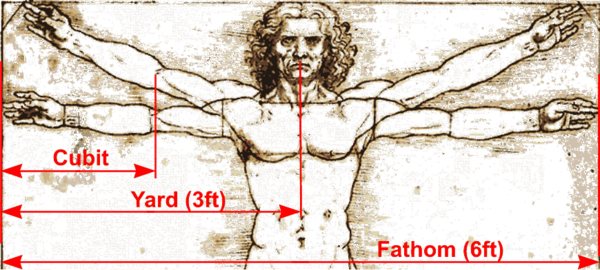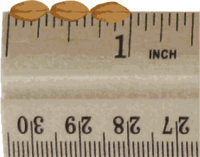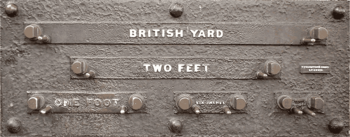The Imperial System of Measurement
From DT Online

Introduction
Exactly how some modern Measurements came about remains open to question but it is clear that it must have always been tempting to use parts of the human body or easily found objects as a starting point.
Archaeologists believe that the Egyptians preferred the Cubit, the length from elbow to finger tip, whilst the Romans and the Greeks preferred the Foot. Even today we may still measure distance by placing one foot in front of another.
Over the centuries the actual length of each of these varied (because people vary) but eventually, in Britain at least, some standard lengths were establish by a statute of King Edward I (1272-1307)
Foot
The Greeks' basic measure used the breadth of a finger and calculated a Foot as 16 fingers long. Conveniently this was very approximately equal to the length of an adult foot. The Romans adapted this but used the breadth of a thumb which gave 12 divisions and was eventually standardised by Marcus Agrippa. This had the advantage of being easily divided into several different fractions.
In Britain following the Roman occupation, the Foot continued to be used and was defined in law following the Norman Conquest during the 13th Century.
Activity:
- Measure the width of your fingers to see how closely they are equal to the length of your foot.
- Repeat this comparison but using the average width of finger and length of foot from everyone in the class – then ask an adult to do the same.

Inches
The Romans divided their Foot into 12 Inches, possibly by using their Thumbs as a gauge. In many European languages even today the word for inch is the same as or derived from the word for thumb.
In Medieval England around 1300 it was ordained that: 3 grains of barley dry and round do make an inch, 12 inches make 1 foot, 3 feet make 1 yard
A Barleycorn is equal to about one third of an Inch and this is still the difference between shoe sizes
Activity:
- Measure Thumbs to see how close they are to one inch then ask an adult to measure theirs.
- Obtain some Barley and devise a way of measuring them to see how close each is to a third of an Inch long.

Yard
Measurements originally were related to parts of the body. They varied considerably and were usually standardised by the local ruler or chieftain, and later by kings. Rods or bars were cut to the correct length and kept in a public place (e.g. Temples in Egypt) where they could be copied and distributed throughout the community.
It is thought that a Yard could have been based on the length of a man’s belt but by the time of the Middle Ages a proper physical standard was needed to ensure fair trade and a standard Yard existed in the form of an iron bar held at Winchester.
A statute of King Edward I (1272-1307) states: It is remembered that the Iron Ulna of our Lord the King contains three feet and no more; and the foot must contain twelve inches.
In 1588 Elizabeth I issued a new standard yard which remained the legal British yard for over 300 years until 1824, when the Weights and Measures Act during the reign of George IV, established the Imperial system of units’’’ and the yard was defined as the Straight Line or Distance between the Centres of the Two Points in the Gold Studs of the Straight Brass Rod now in the Custody of the Clerk of the House of Commons whereon the Words and Figures "Standard Yard 1760" are engraved. The British Imperial System remained in use until the adoption of the metric system beginning in 1965 and is still the basis of measurement in America.